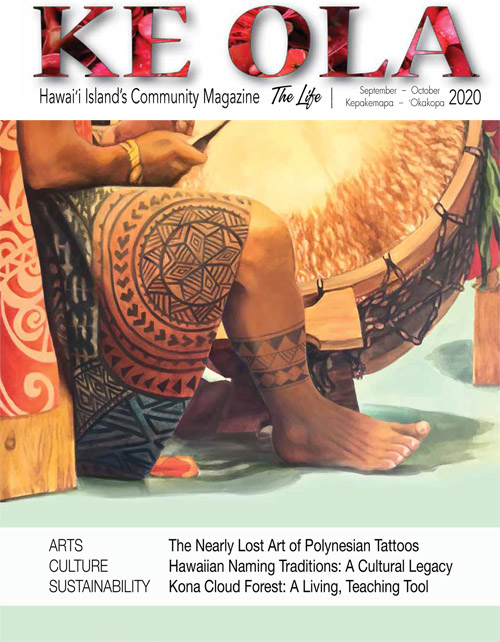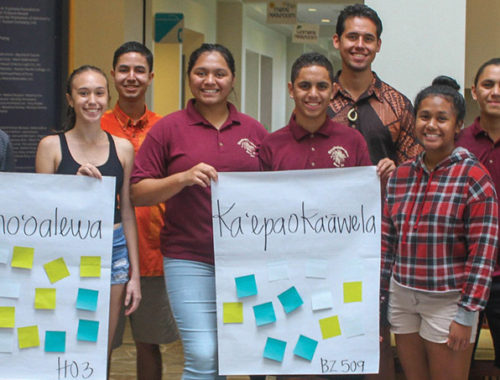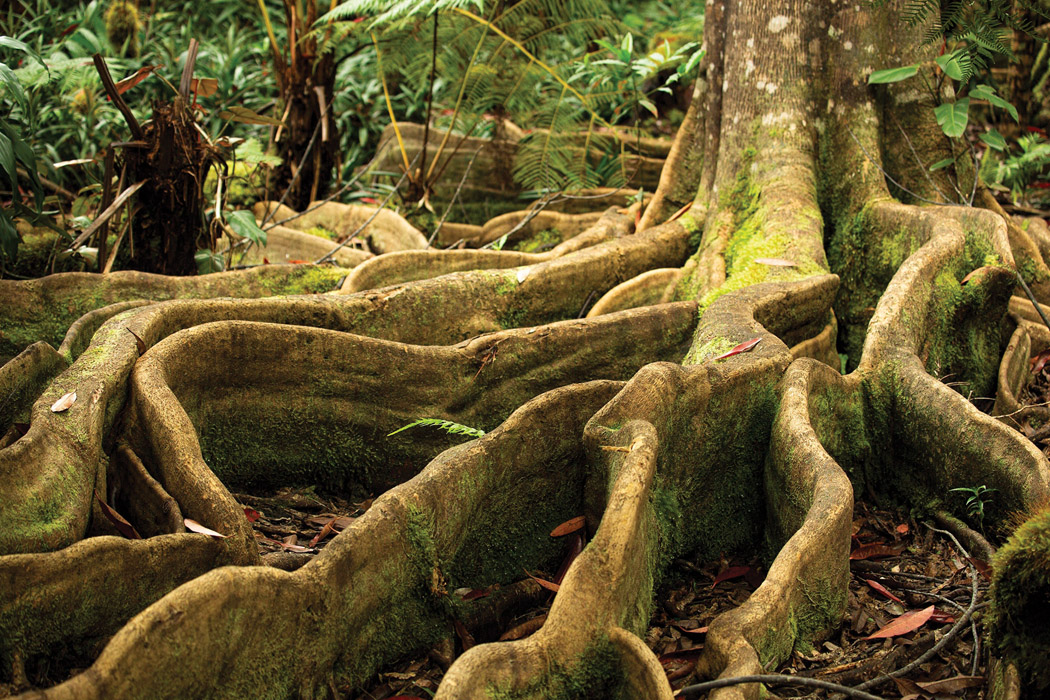
Kona Cloud Forest Sanctuary: A Living, Teaching Tool

By Fern Gavelek
The sun goes in and out of rain-filled clouds while driving up Koloko Mauka to the Kona Cloud Forest Sanctuary (KCFS). Upon arrival, the air is cool and damp, smelling of dew and moist earth. The sun reappears, giving wet leaves a joyous sparkle. There’s a feeling of freshness and life anew. All this lushness is a mere 15-minute drive above the barren lavascape of Konaʻs airport.
Located at a 3,000-foot elevation, KCFS is part of Kona’s cloud forest stretching 50 miles long, according to Norm Bezona, the sanctuary’s visionary and horticulture director.
“The cloud forest is an important watershed that has been continually pecked away through the years for agricultural use and urban sprawl,” he continues. “Here, we hope to preserve the native forest, keep it functioning as a cloud forest, and be an example of what others can do to reforest an area.”
A professor emeritus and retired extension agent with the University of Hawai‘i College of Tropical Agriculture and Human Resources, Norm is a walking encyclopedia on growing plants—both in home gardens and as agricultural commodities. Many residents read Norm’s weekly horticulture columns on Sundays in both the islandʻs newspapers.
Norm first started the sanctuary on property he purchased in 1980 for his family compound. He still lives on site with partner Voltaire Moise and, also residing at the sanctuary, are Norm’s children and grandchildren. However, Norm soon learned the sanctuary could have a broader purpose and opened it up for community use.
Sharing a Community Resource
“As an educator, I found you can teach students best when you get them out of a classroom and into the living environment,” states Norm. The sanctuary has been hosting botanical tours and educational programs since 1984 while serving as a meeting location for local horticulture-themed organizations.
Today, the 70-acre KCFS operates as an educational nonprofit in partnership with the Bezona Family Trust. Part of it is protected as a conservation easement in perpetuity through the Hawaiian Islands Land Trust. Norm provides on-site classes and tours geared for horticulturists and allows select tour operators to provide guided visits geared for the public. One of them is Kelly Dunn of the Painted Trees of Hawaii Foundation who presents compelling forest treks through his nonprofit. Since 2015, Kelly and his teams of volunteers have painstakingly created trails—without the use of gas and electric tools—to better access the forest and, as Kelly says, “showcase what people have never seen before.”
Kona’s Rainy Summer Weather Creates Nation’s Only Tropical Cloud Forest
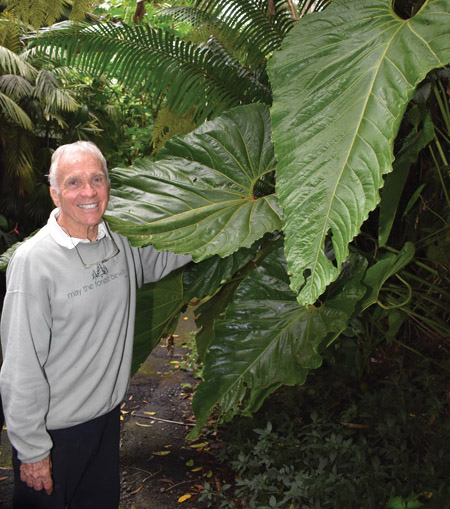
Also called “fog forests,” cloud forests are characterized by frequent, low-level cloud cover. They are dependent on local climate, elevation, and latitude. Norm notes the Kona Cloud Forest “is the only tropical cloud forest in the US” and attributes it to Kona’s unique weather.
“Kona’s weather is ruled by a daily convection pattern involving sun, ocean, and mountain topography,” he explains. “Unlike the rest of the state, Kona is wetter in the summer and drier in the winter.”
The way Kona’s convective weather pattern works is prevailing winds from the east are blocked by Mauna Loa and Hualālai. In the absence of strong trade winds, morning heating of the land draws moist air from the ocean to cause upslope winds during the day. When this warm, moist air reaches the cooler middle elevations, it condenses and turns into clouds, mist, or rain. Wind direction reverses at night when cooled mountain air moves downslope pushing the warmer air up and out to sea. Warmer summer temps intensify this process, resulting in Kona’s wetter summers.
Serving as an Important Watershed
There’s a Hawaiian proverb: Hahai no ka ua i ka ululā‘au (The rain follows the forest). The Kona cloud forest, with its sprawling canopy of vegetation, serves as a collection reservoir for Kona’s convective showers.
“The trees are important because they attract and hold the clouds,” details Norm. “Without the trees, you get 40% or more less precipitation. Here in the cloud forest, we average 100 inches of rain annually. It percolates through the soil and subsurface to recharge the aquifer.”
KCFS sits on the 1801 lava flow of Hualālai and the majority of its acreage is “pure, native forest” with primarily old ‘ōhi‘a and koa, 30-foot tree ferns, and other native ferns. When Norm got involved with the area in 1980, his priority was reestablishing forest on 15 acres that had been previously pastured for livestock.
To do this, he relied on native and non-native species supplied by the forestry service, nurseries, and local plant societies for testing the viability of varieties of palms, bamboos, tropical rhododendrons, orchids, and more. Observations were made and continue regarding these plants’ adaptability for reforestation, plus agricultural and landscape use.
“Even though the sanctuary is preserved in native forest, the upper portion is now reforested as a montane tropical forest and includes koa, ‘ōhi‘a and conifers from the high tropics,” notes Norm.
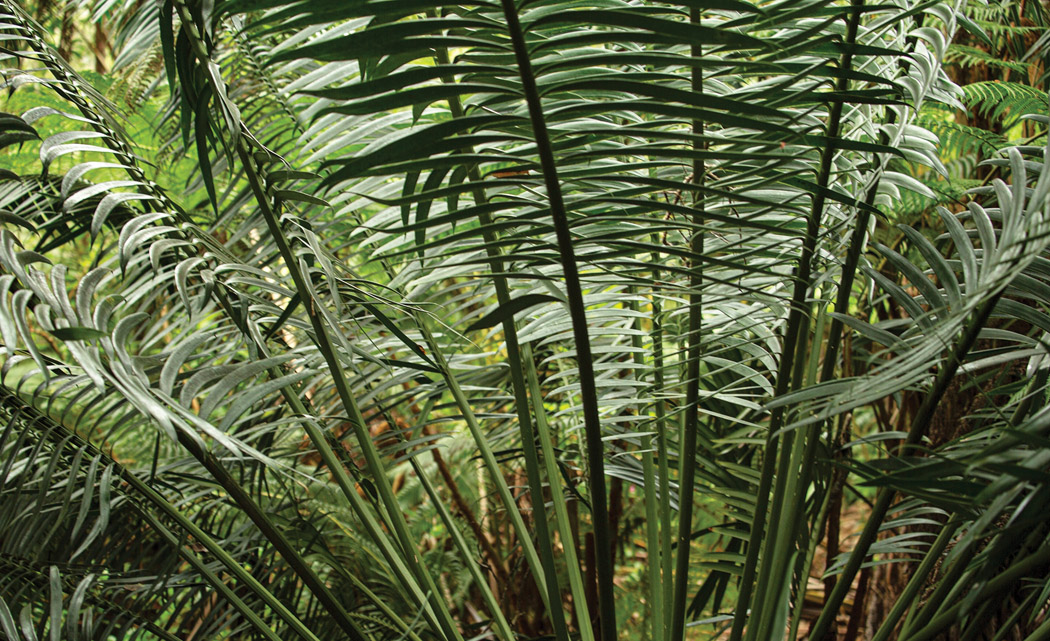
Plant a Tree to Fight Global Warming
While the reforestation of the 15 acres adds to the function of Kona’s watershed, Norm adds every tree we plant “does its little bit” to sequester carbon and produce oxygen. “Trees naturally remove carbon dioxide in the atmosphere, which helps reduce global warming,” he emphasizes. “Global warming is no longer a theory; it is accepted as fact by most scientists and governments and will affect our island by causing more weather extremes: drought, floods, and severe storms.”
Norm points out that “here at home” we can do our part to combat global warming. “If each one of us on the Big Island planted only 10 trees this year, we will have planted more than one million,” he stresses. “Trees not only produce oxygen and lock up carbon, they also supply shade, act as wind breaks, and produce food.”
Cloud Forest Walking Tours with Painted Trees of Hawaii
The focus of Kelly Dunn’s sanctuary tours is to reconnect guests with nature while wowing them along the way.
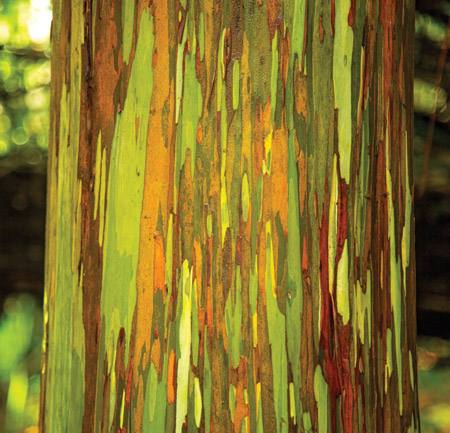
“My goal with tours is for people to have a better understanding about nature and how they can interact with it,” shares Kelly. “Hopefully they will go out and plant something…or join an eco-club or volunteer to give back to nature. You don’t need a degree to plant a tree.”
A Michigan native, Kelly moved to Hilo in 1983 and fell in love with the Hawai‘i Tropical Botanical Garden at Onomea Bay. He photographed plants there and his favorite subject was the massive rainbow (painted) eucalyptus trees with their colorful, striated trunks. Kelly noticed they were disappearing on the island and started his Painted Trees of Hawaii Foundation to educate people about them with the goal of collecting seeds to create a walking trail.
It was at one of Kelly’s Painted Tree presentations where he met Norm and was invited to bring his foundation work to the sanctuary where he could walk among the existing painted trees already flourishing in the cloud forest. Norm points out the rainbow eucalyptus, Eucalyptus deglupta, is the only species of eucalyptus native to the northern hemisphere.
Kelly took Norm up on the offer and with his blessing, spent a year and a half carefully cutting new trails to best view the diversity of Kona’s cloud forest.
Volunteers Responsible for KCFS Trails
To create the trails and maintain them, Kelly relies on volunteers through corporation employee give-back programs and community service opportunities in partnership with the District Court of Third Circuit. In lieu of paying fines for violations such as parking tickets, offenders can be ordered to perform community service at KCFS.
“Weʻve had about 200 court-ordered workers,” notes Kelly. “They typically work 75 hours and after they’re done, about 20% of them return to volunteer.”
Creating Ah-Ha! Tour Moments
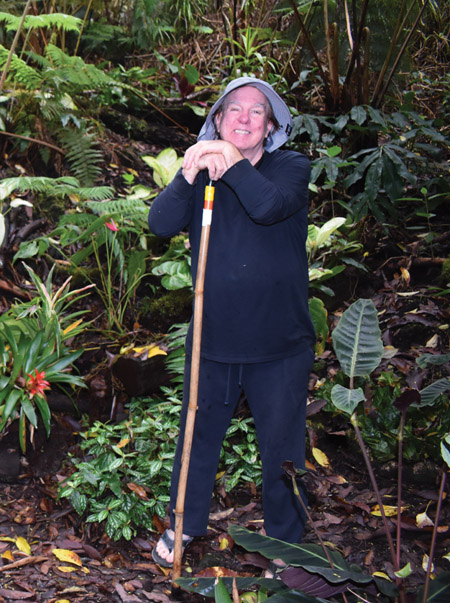
For his Painted Trees Tours, Kelly created a narrative that identifies and shares the traditional medicinal, cultural, and culinary qualities of select trees, plants, and flowers. The main trail visits a dozen painted trees, tree ferns, ‘ōhi‘a, and plants like the prehistoric-looking Hope’s cycad, Lepidozamia hopei. Other standouts include the sanctuary’s bamboos—they can grow up to three feet in a day—and the blue marble tree, which bears iridescent, globular fruit.
“There are a lot of Ah-Ha! moments on the tour,” smiles Kelly. “Guests are in awe when I explain how plants grow here in the cloud forest, really without dirt, and instead are dependent on the decomposing leaf litter on the forest floor, the wet environment, filtered sunlight, and the cool temps.”
During his top-ranked activity by TripAdvisor, Kelly aims for people to see the world as he does. “I want them to slow down and really look at nature with new eyes,” he details, adding he illustrates the benefit of slowing down by playing “Where’s Waldo” with bamboo. “Most people leave here and see nature in a different way.” ❖
Public tours: paintedtreesofhawaii.org
Horticulture classes/tours: konacloudforest.com
